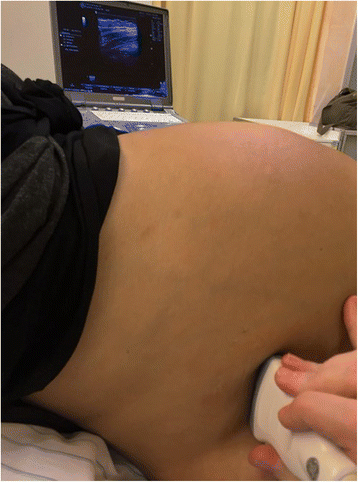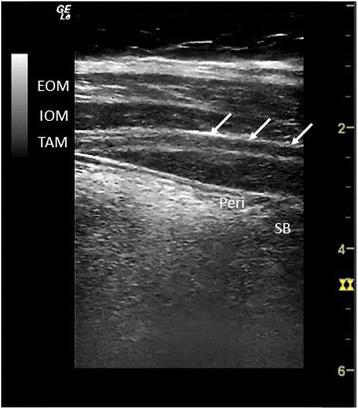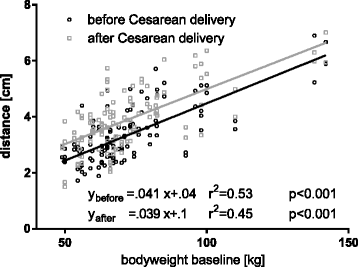Ultrasound anatomy of the transversus abdominis plane region in pregnant women before and after cesarean delivery
- PMID: 28007030
- PMCID: PMC5180404
- DOI: 10.1186/s12871-016-0289-8
Ultrasound anatomy of the transversus abdominis plane region in pregnant women before and after cesarean delivery
Abstract
Background: After cesarean delivery, analgesia is often incomplete and a multimodal approach to analgesia is necessary. Transverse abdominal plane (TAP) block has been advocated in this setting, yet no systematic description of the ultrasound anatomy in pregnant women exists in the literature. Therefore, we aimed to describe the sonographical features of relevant structures in pregnant women before and after elective cesarean.
Methods: Sixty women at, or close to term scheduled for elective cesarean delivery underwent a standardized ultrasound examination before and after delivery. We assessed the visibility of the muscular layers and measured the distance from the skin to the layers of the abdominal wall muscles in the region for TAP block before and after cesarean section on both side.
Results: The three muscular layers of the lateral abdominal wall (external oblique, internal oblique and transversus abdominis muscle) were visible in all examinations. Before cesarean section the median TAP distance was shorter: 2.9 cm (interquartile range 2.6-3.6) compared to 3.9 cm (3.1-4.5) after cesarean section (left side, p < 0.001). The external and internal oblique muscles were located closer to the skin surface before cesarean section. An increased body mass is associated with increased the TAP distance before and after birth (p < 0.001).
Conclusion: Relevant anatomical landmarks for a TAP block are sonographically well visible after cesarean delivery. Postoperatively, depth of the TAP as compared to before birth is increased significantly. Scanning the abdominal wall before CD will underestimate the target depth of the TAP after delivery. The obstetric anesthetist needs to be aware of these changes when planning a TAP block in the context of cesarean delivery.
Keywords: Cesarean delivery; Transversus abdominis plane block; Ultrasound.
Figures



Similar articles
-
EVALUATION OF ULTRASONOGRAPHIC ANATOMY OF TRANSVERSUS ABDOMINIS PLANE BEFORE AND AFTER CESAREAN SECTION.Acta Clin Croat. 2022 Mar;61(1):3-10. doi: 10.20471/acc.2022.61.01.01. Acta Clin Croat. 2022. PMID: 36398073 Free PMC article.
-
The analgesic efficacy of subarachnoid morphine in comparison with ultrasound-guided transversus abdominis plane block after cesarean delivery: a randomized controlled trial.Anesth Analg. 2010 Aug;111(2):475-81. doi: 10.1213/ANE.0b013e3181e30b9f. Epub 2010 May 20. Anesth Analg. 2010. PMID: 20488929 Clinical Trial.
-
Bilateral ultrasound-guided transversus abdominis plane block combined with ilioinguinal-iliohypogastric nerve block for cesarean delivery anesthesia.Anesth Analg. 2011 Jul;113(1):134-7. doi: 10.1213/ANE.0b013e31821891e2. Epub 2011 Apr 5. Anesth Analg. 2011. PMID: 21467562
-
Role of transversus abdominis plane block after caesarean delivery.Curr Opin Anaesthesiol. 2013 Jun;26(3):268-72. doi: 10.1097/ACO.0b013e328360fa16. Curr Opin Anaesthesiol. 2013. PMID: 23587731 Review.
-
High-dose versus low-dose local anaesthetic for transversus abdominis plane block post-Caesarean delivery analgesia: a meta-analysis.Br J Anaesth. 2018 Feb;120(2):252-263. doi: 10.1016/j.bja.2017.11.084. Epub 2017 Dec 5. Br J Anaesth. 2018. PMID: 29406174
Cited by
-
An Evaluation of the Adding Magnesium Sulfate to Ropivacaine on Ultrasound-Guided Transverse Abdominis Plane Block After Abdominal Hysterectomy.Anesth Pain Med. 2018 Jul 29;8(4):e74124. doi: 10.5812/aapm.74124. eCollection 2018 Aug. Anesth Pain Med. 2018. PMID: 30250819 Free PMC article.
-
Comparison of ultrasound-guided iliohypogastric/ilioinguinal nerve block and transversus abdominis plane block for analgesia after cesarean section: A retrospective propensity match study.Exp Ther Med. 2019 Jul;18(1):289-295. doi: 10.3892/etm.2019.7540. Epub 2019 May 3. Exp Ther Med. 2019. PMID: 31258664 Free PMC article.
-
EVALUATION OF ULTRASONOGRAPHIC ANATOMY OF TRANSVERSUS ABDOMINIS PLANE BEFORE AND AFTER CESAREAN SECTION.Acta Clin Croat. 2022 Mar;61(1):3-10. doi: 10.20471/acc.2022.61.01.01. Acta Clin Croat. 2022. PMID: 36398073 Free PMC article.
References
-
- Centers for Desease Control and Prevention. FastStats [Internet]. [cited 2015 Mar 27]. Available from: http://www.cdc.gov/nchs/fastats/delivery.htm
Publication types
MeSH terms
LinkOut - more resources
Full Text Sources
Other Literature Sources
Medical
Miscellaneous

